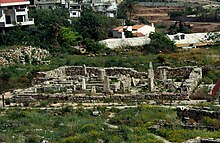 Temple of the Obeliques, Lebanon. | |
| Location | Byblos |
|---|---|
| Coordinates | 34°07′08″N 35°38′50″E / 34.11889°N 35.64722°E |
| Site notes | |
| Excavation dates | 1922 |
The Temple of the Obelisks (French: Temple aux Obelisques, Arabic: معبد الأنصاب maebad al'ansab), also known as the L-shaped Temple and Temple of Resheph[1] was an important Bronze Age temple structure in the World Heritage Site of Byblos.[2] It is considered "perhaps the most spectacular" of the ancient structures of Byblos.[3] It is the best preserved building in the Byblos archaeological site.[4]
Almost all of the artefacts found in the excavation of the temple are displayed at the National Museum of Beirut.[3] It was excavated by French archaeologist Maurice Dunand from 1924-73. The original temple is now in two parts: the base is known as "the L-shaped temple", and the top is known as the "Temple of the Obelisks"; the latter was moved 40 meters east during Maurice Dunand's excavations.[2]
Dunand uncovered 1306 Byblos figurines – ex-voto offerings, including faience figurines, weapons, and dozens of bronze-with-gold-leaf figurines – which have become the "poster child" of the Lebanese Tourism Ministry.[5]
- ^ Kilani 2019, p. 57a...based on a disputed translation of the Abishemu obelisk
- ^ a b Boda 1994, p. 146.
- ^ a b Michaelides 2001, p. 21.
- ^ Kilani 2019, p. 57.
- ^ Steiner, Margreet L.; Killebrew, Ann E. (2014). The Oxford Handbook of the Archaeology of the Levant: C. 8000-332 BCE. OUP Oxford. pp. 465–. ISBN 978-0-19-921297-2.
